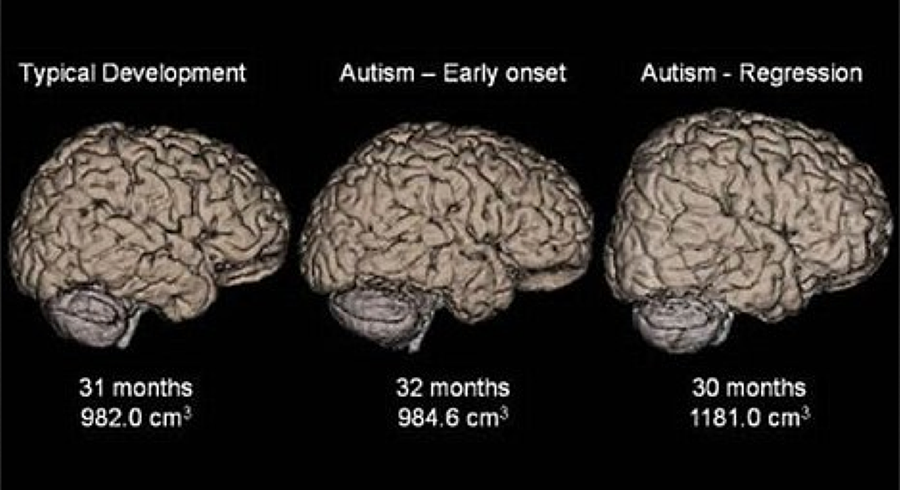MRI Technique Shows Brain Differences in People on Autism Spectrum
Researchers have observed abnormal neural networks in preschoolers with autism spectrum disorder (ASD) using a specialized magnetic resonance imaging (MRI) technique. The discovery gives hope that MRI scanning may one day allow early diagnosis, intervention, and treatment in ASD.
It took place over four years in the Chinese PLA Hospital in Beijing. The researchers used a special MRI technique called diffusion-tensor imaging (DTI), which allowed them to observe the location, orientation, and anisotropy of white matter tracts in the children's brains.
Other scientists have used a similar technique to study the brains of patients with Alzheimer disease, multiple sclerosis, epilepsy, and other psychiatric disorders. The approach has led to
an improved understanding of topological organization of the brain network in patients with these disorders.
There were similarly useful results in the study of preschoolers with ASD. The researchers observed alterations of white matter in the children with ASD compared to children with TD. The scientists were able to correlate the alterations in the white matter networks with delays in verbal communication, object use, visual response, body use, and listening response.
That observation agreed with previous studies that had observed this phenomenon in adults on the autism spectrum. The researchers believe this is a reflection of a delayed maturation process in people with ASD.
"Altered brain connectivity may be a key pathophysiological feature of ASD," study co-author Lin Ma told Science Daily. "This altered connectivity is visualized in our findings, thus providing a further step in understanding ASD. The imaging finding of those 'targets' may be a clue for future diagnosis and even for therapeutic intervention in preschool children with ASD."
"This discovery gives us a more objective diagnostic method by using MRIs to aid us in the diagnosis of children who do have autism, and also gives us a better understanding of the abnormal differences in the brain," psychiatrist Dr. Matthew Lorber told HealthDay Reporter.
Doctors presently diagnose ASD through observing difficulties with social use of communication and interaction in children. A standardized MRI technique that could identify the disorder could give parents and therapists an earlier chance at intervention and treatment.
It's still too early to rely on MRI scans for the diagnosis of autism, but the study's results show that it's possible. The study also provides other researchers with imaging biomarkers that may speed the development of this technology.
References
"Abnormal Brain Connections Seen in Preschoolers with Autism." Science Daily. 27 Mar. 2018. Accessed 29 Mar. 2018.
"DSM-5 Diagnostic Criteria." Autism Speaks. 2018. Accessed 29 Mar. 2018.
Ma, Lin et al. "Alterations of White Matter Connectivity in Preschool Children with Autism Spectrum Disorder." Radiology. 27 Mar. 2018. doi: 10.1148/radiol.2018170059. [Epub ahead of print]. Accessed 29 Mar. 2018.
Preidt, Robert. "MRI Sheds New Light on Brain Networks Tied to Autism." HealthDay Reporter. 27 Mar. 2018. Accessed 29 Mar. 2018.
The study included 21 children with ASD and 21 children with typical development (TD).
It took place over four years in the Chinese PLA Hospital in Beijing. The researchers used a special MRI technique called diffusion-tensor imaging (DTI), which allowed them to observe the location, orientation, and anisotropy of white matter tracts in the children's brains.
Other scientists have used a similar technique to study the brains of patients with Alzheimer disease, multiple sclerosis, epilepsy, and other psychiatric disorders. The approach has led to
an improved understanding of topological organization of the brain network in patients with these disorders.
There were similarly useful results in the study of preschoolers with ASD. The researchers observed alterations of white matter in the children with ASD compared to children with TD. The scientists were able to correlate the alterations in the white matter networks with delays in verbal communication, object use, visual response, body use, and listening response.
The study also observed increased nodal efficiency in children with ASD compared with TD.
That observation agreed with previous studies that had observed this phenomenon in adults on the autism spectrum. The researchers believe this is a reflection of a delayed maturation process in people with ASD.
"Altered brain connectivity may be a key pathophysiological feature of ASD," study co-author Lin Ma told Science Daily. "This altered connectivity is visualized in our findings, thus providing a further step in understanding ASD. The imaging finding of those 'targets' may be a clue for future diagnosis and even for therapeutic intervention in preschool children with ASD."
Medical professionals from around the world weighed in on the study.
"This discovery gives us a more objective diagnostic method by using MRIs to aid us in the diagnosis of children who do have autism, and also gives us a better understanding of the abnormal differences in the brain," psychiatrist Dr. Matthew Lorber told HealthDay Reporter.
Doctors presently diagnose ASD through observing difficulties with social use of communication and interaction in children. A standardized MRI technique that could identify the disorder could give parents and therapists an earlier chance at intervention and treatment.
It's still too early to rely on MRI scans for the diagnosis of autism, but the study's results show that it's possible. The study also provides other researchers with imaging biomarkers that may speed the development of this technology.
References
"Abnormal Brain Connections Seen in Preschoolers with Autism." Science Daily. 27 Mar. 2018. Accessed 29 Mar. 2018.
"DSM-5 Diagnostic Criteria." Autism Speaks. 2018. Accessed 29 Mar. 2018.
Ma, Lin et al. "Alterations of White Matter Connectivity in Preschool Children with Autism Spectrum Disorder." Radiology. 27 Mar. 2018. doi: 10.1148/radiol.2018170059. [Epub ahead of print]. Accessed 29 Mar. 2018.
Preidt, Robert. "MRI Sheds New Light on Brain Networks Tied to Autism." HealthDay Reporter. 27 Mar. 2018. Accessed 29 Mar. 2018.

